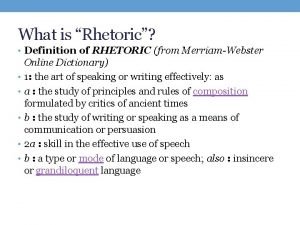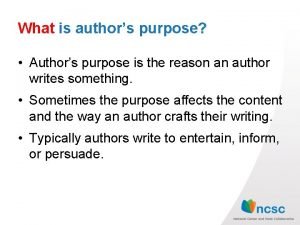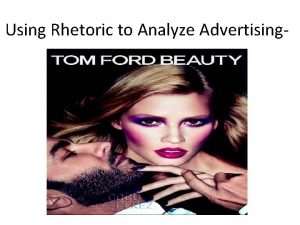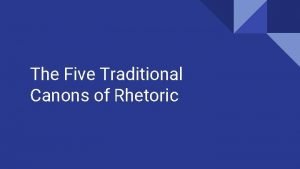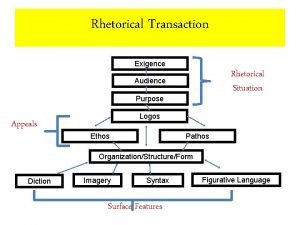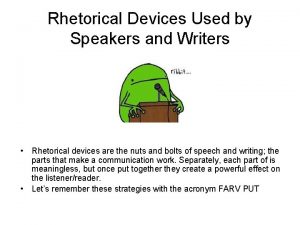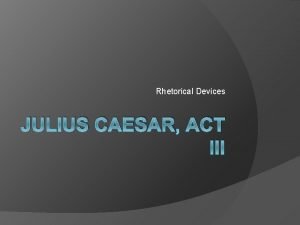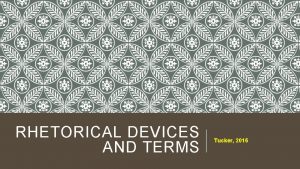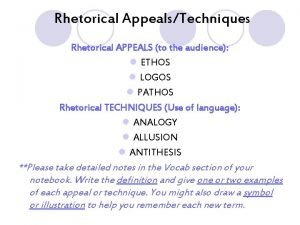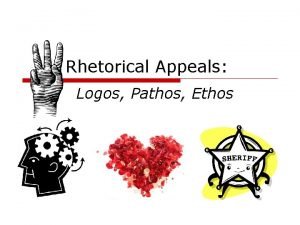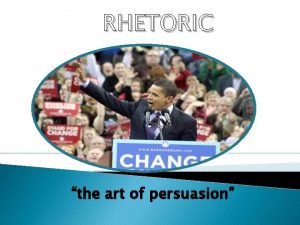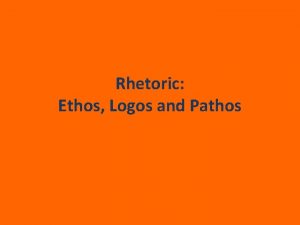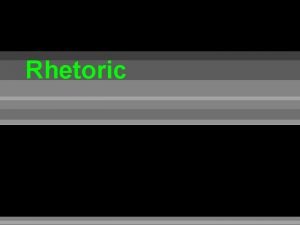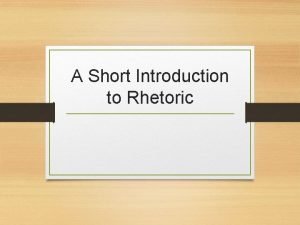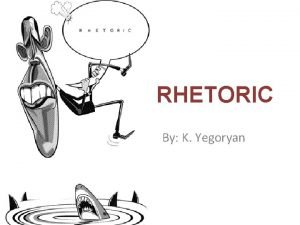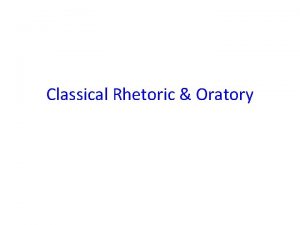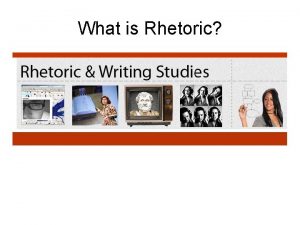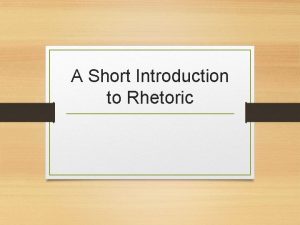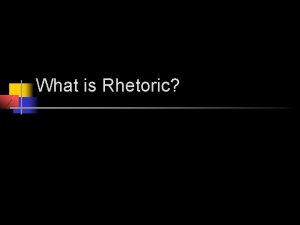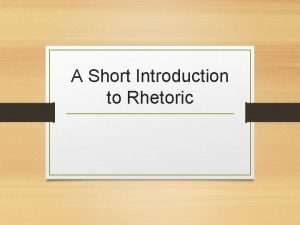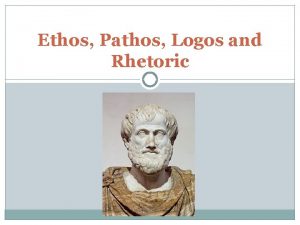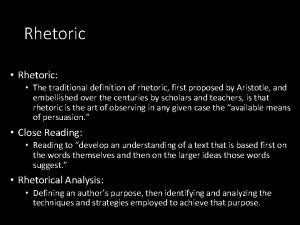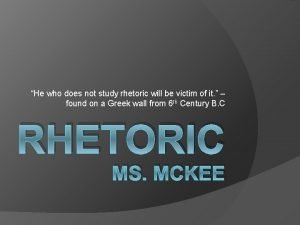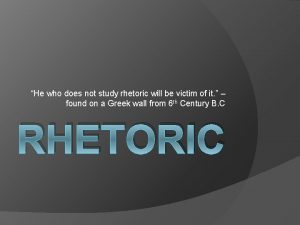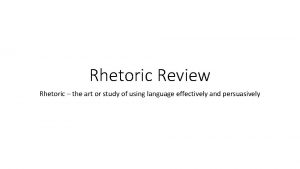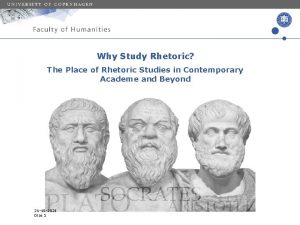RHETORIC He who does not study rhetoric will


















- Slides: 18

RHETORIC “He who does not study rhetoric will be victim of it. ” – found on a Greek wall from 6 th Century B. C.

Developing Skill with Rhetoric: The Rhetorical Triangle “Words—so innocent and powerless as they are, as standing in a dictionary, how potent for good and evil they become in the hands of one who knows how to combine them. ” —Nathaniel Hawthorne

What is Rhetoric? � The art of communication… � Analysis and comprehension of how a writer or speaker has achieved his or her effect from a text on an audience. � What does this mean to you?

The Three Appeals: Ethos, Pathos, and Logos

Ethos: Understanding the Ethical Appeal � � � Ethos = the writer or speaker’s credibility on his or her subject; the speaker’s ability to acknowledge the opposing view What can we tell about the “character” of the speaker? If we don’t know the author, then we have to look at his or her text: • Tone of the text • Persona

Situated and Invented Ethos Situated Ethos The kind of character developed “around” the speaker/writer. Whenever we are dealing with writers we know, writers who have been talked about a great deal or popular figures that we encounter in the press, these writers have an established ethos situated in who they are and how they have been represented. � Invented Ethos The kind of character developed “in the text, ” the ways that the writer’s words and phrases, as well as selection of examples and ideas, establish the writer’s authority. �

Situated and Invented Ethos Examples George W. Bush was the son of a political family— his father and been vice president for eight years and was then president for four years. He had also served in many political offices before that. In addition, the family is known for its “wealth. ” Barack Obama is the first U. S. president born in Hawaii. He is the son of parents who divorced when he was still very young. He attended Harvard Law School and became the first black president of the United States.

Pathos: Understanding the Pathetic (Emotional) Appeal � � Pathos = an emotional appeal upon the audience Most people make decisions based upon a more emotional than logical basis

Logos: Understanding Logical Appeal � � Logos = the methods of persuasion within the language itself (logos = word; “logic”) How the argument is supported (facts, statistics, words of experts and examples)

Why Rhetoric? “I would hurl words into this darkness and wait for an echo, and if an echo sounded, no matter how faintly, I would send other words to tell, to march , to fight, to create a sense of hunger for life that gnaws in us all. ” --Richard Wright

Six Keys of Rhetoric Skills � � � Persona Appeals to Audience Subject Matter and Its Treatment Context Intention Genre

#1: Understanding Persona Reason for Importance: � � So you don’t get fooled by the author The writer/speaker creates a persona to make himself or herself more believable and trustworthy so that the audience will buy into what he or she is saying Persona = the “mask” or character the writer or speaker creates for him/herself

#2: Understanding the Appeals to the Audience THE THREE APPEALS: Ethos Pathos Logos

#3 Subject Matter and Its Treatment � When deciding what kinds of information to include in a text, writers and speakers need to keep in mind… INTENTION: What is the purpose of the text? What am I trying to achieve? AUDIENCE: To whom is the text directed? GENRE: What kind of text is most appropriate for my audience?

#4: Context DEFINITION: HOW SOCIETY IMPACTS THE SUBJECT OF A TEXT � � An effective writer or speaker knows how to refer to context to help the audience understand the position he or she takes and to connect positively with his or her argument A careful reader understands how context affects the text he or she is

#5: Intention INTENTION = PURPOSE What the writer or speaker wants to happen as a result of the text; what he or she wants the audience to believe or do after hearing or reading the text PURPOSE OF THE TEXT: • To persuade • To inform • To entertain • To call to action

#6: Genre ust I m y h W at I h w e t wri Who ? e t i r w ear h o t s need this? � audience + purpose = most appropriate genre � Questions the writer or speaker should ask to help find the most appropriate genre of text: 1. 2. 3. Malala Yousafzai What is the context calling forth a piece of writing? Who needs to know what I intend to write about? What is the best, most appropriate genre to produce?

Works Cited Banks, William P. “A Short Handbook on Rhetorical Analysis. ” 2001. 27 Feb. 2007. http: //english. ecu. edu/~wpbanks/rhetoric/rhetanalysis. html. Roskelly, Hephzibah & Joliffe, David. Everyday Use: Rhetoric at Work in Reading and Writing. Pearson Longman, New York: 2005. * Presentation adapted from Docstoc. com
 Uncontrolled, lacking in restraint
Uncontrolled, lacking in restraint Visual rhetoric
Visual rhetoric Rhetoric definition
Rhetoric definition Author
Author What is rhetoric
What is rhetoric 3 types of rhetoric
3 types of rhetoric Canons of rhetoric
Canons of rhetoric Ethos pathos logos plato
Ethos pathos logos plato Cicero rhetorical devices
Cicero rhetorical devices Shooting an elephant exigence
Shooting an elephant exigence Rhetorical devices
Rhetorical devices Parallelism in literature
Parallelism in literature Example of ethos in julius caesar
Example of ethos in julius caesar Anastrophe examples sentences
Anastrophe examples sentences Rhetorical advertisement
Rhetorical advertisement Ethos rhetoric
Ethos rhetoric Rhetoric: the art of persuasive writing and public speaking
Rhetoric: the art of persuasive writing and public speaking Ethos pathos logos
Ethos pathos logos Pathos examples
Pathos examples


